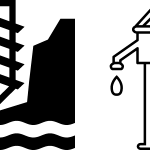The 141 community members of Suctarr struggle to access sufficient water. People must travel long distances to a neighboring community's well, but its water is often contaminated. The only other option isn't really an option at all. There is another well nearby, but it is private, therefore people cannot use it.

Field Officer Alie Kamara said, "It is obviously heart-wrenching for the community as they do not have any other means to fetch water but from a protected dug well without a hand pump. They only use a five-gallon container and rope and pull some water from the well. This method of fetching water from this well is not easy for the community members. It requires time and energy to make many trips."
Adults and children must sacrifice crucial time in the water collection process that steals from the other important things in their lives.
34-year-old trader Isatu Kamara, shown below, shared how the water crisis affects her life. "Every day, I walk long distances to access the water, and I'm not able to make many trips due to the distance and the method of fetching water [from] this well. Sometimes, I am late to go to the market, and this will cause me to prepare food for my family late. I must make sure my children and I fetch enough water [to] fill all the rubber buckets before we rest, and we spend a long time at the well before we can complete filling all the containers."

"Then, they will be late to go to school. This water is not safe to drink, but it is the only water that is available in my community. Though there is a water well close to my house, it is a private well inside a fence, and it is restricted to people. I would be grateful if this organization would provide [a] water well in my community," she continued.
15-year-old Salamatu C., seen below, shared, "I find it hard to fetch water, especially in the morning hours. This is because many people will be at the water point patiently waiting for their turn. The long waiting time delays me from fetching water earlier. Therefore, the things I should have done at home will be left undone unless I do them after school. In the same way, the long distance to the water point also affects me, as I must walk far to fetch water from the well after school."

People in the Suctarr community often speak of how exhausted they are because the water crisis is physically and mentally draining.
"This is really challenging, mostly when the sun is warm. Walking [a] far distance to fetch water on an empty stomach is hard. Another challenge I face is that the well is hard to fetch water [from]. I must draw water from the well [using a] five-gallon container tied with a rope. There was a time [when] the five-gallon [container] fell inside the well with the rope. I [had to] find ways to remove the five-gallon [bucket] inside the well or ask an elder to remove it. I find [it] hard to access water," Salamatu continued.

Installing a well in the Suctarr Community will enable people like Isatu to prioritize their livelihoods and provide for their families and children like Salamatu to fetch water easily and quickly, allowing dreams of a brighter future.
The Proposed Solution, Determined Together...
At The Water Project, everyone has a part in conversations and solutions. We operate in transparency, believing it benefits everyone. We expect reliability from one another as well as our water solutions. Everyone involved makes this possible through hard work and dedication.
In a joint discovery process, community members determine their most advantageous water solution alongside our technical experts. Read more specifics about this solution on the What We're Building tab of this project page. Then, community members lend their support by collecting needed construction materials (sometimes for months ahead of time!), providing labor alongside our artisans, sheltering and feeding the builders, and supplying additional resources.
Water Access for Everyone
This water project is one piece in a large puzzle. In Kenya, Sierra Leone, and Uganda, we're working toward complete coverage of reliable, maintained water sources that guarantee public access now and in the future within a 30-minute round trip for each community, household, school, and health center. One day, we hope to report that this has been achieved!
Training on Health, Hygiene & More
With the community's input, we've identified topics where training will increase positive health outcomes at personal, household, and community levels. We'll coordinate with them to find the best training date. Some examples of what we train communities on are:
- Improved hygiene, health, and sanitation habits
- Safe water handling, storage & treatment
- Disease prevention and proper handwashing
- Income-generation
- Community leadership, governance, & election of a water committee
- Operation and maintenance of the water point



 Rehabilitation Project
Rehabilitation Project
























